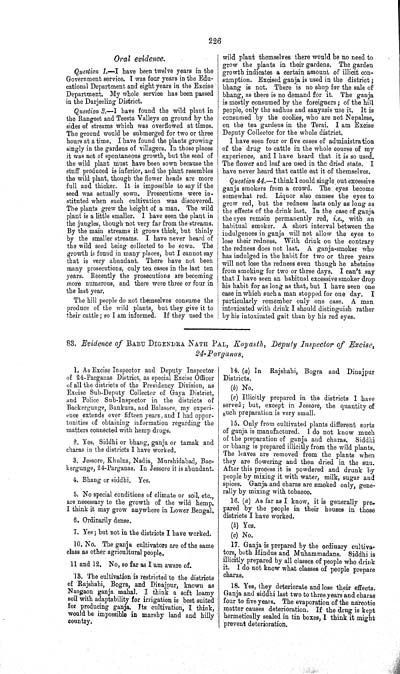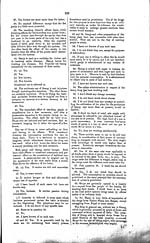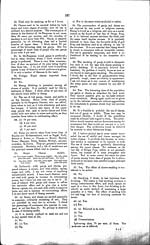Medicine - Drugs > Report of the Indian Hemp Drugs Commission, 1894-1895 > Volume IV
(240) Volume 4, Page 226
Thumbnail gallery: Grid view | List view

226
Oral evidence.
Question 1.—I have
been twelve years in the
Government service. I was four years in the Edu-
cational Department and eight years in the Excise
Department. My whole service has been passed
in the Darjeeling District.
Question 3.—I have
found the wild plant in
the Rangeet and Teesta Valleys on ground by the
sides of streams which was overflowed at times.
The ground would be submerged for two or three
hours at a time. I have found the plants growing
singly in the gardens of villagers. In those places
it was not of spontaneous growth, but the seed of
the wild plant must have been sown because the
stuff produced is inferior, and the plant resembles
the wild plant, though the flower heads are more
full and thicker. It is impossible to say if the
seed was actually sown. Prosecutions were in-
stituted when such cultivation was discovered.
The plants grew the height of a man. The wild
plant is a little smaller. I have seen the plant in
the jungles, though not very far from the streams.
By the main streams it grows thick, but thinly
by the smaller streams. I have never heard of
the wild seed being collected to be sown. The
growth is found in many places, but I cannot say
that is very abundant. There have not been
many prosecutions, only ten cases in the last ten
years. Recently the prosecutions are becoming
more numerous, and there were three or four in
the last year.
The hill people do not
themselves consume the
produce of the wild plants, but they give it to
their cattle; so I am informed. If they used the
wild plant themselves
there would be no need to
grow the plants in their gardens. The garden
growth indicates a certain amount of illicit con-
sumption. Excised ganja is used in the district;
bhang is not. There is no shop for the sale of
bhang, as there is no demand for it. The ganja
is mostly consumed by the foreigners; of the hill
people, only the sadhus and sanyasis use it. It is
consumed by the coolies, who are not Nepalese,
on the tea gardens in the Terai. I am Excise
Deputy Collector for the whole district.
I have seen four or five
cases of administration
of the drug to cattle in the whole course of my
experience, and I have heard that it is so used.
The flower and leaf are used in the dried state. I
have never heard that cattle eat it of themselves.
Question 44.—I
think I could single out excessive
ganja smokers from a crowd. The eyes become
somewhat red. Liquor also causes the eyes to
grow red, but the redness lasts only as long as
the effects of the drink last. In the case of ganja
the eyes remain permanently red, i.e., with an
habitual smoker. A short interval between the
indulgences in ganja will not allow the eyes to
lose their redness. With drink on the contrary
the redness does not last. A ganja-smoker who
has indulged in the habit for two or three years
will not lose the redness even though he abstains
from smoking for two or three days. I can't say
that I have seen an habitual excessive smoker drop
his habit for as long as that, but I have seen one
case in which such a man stopped for one day. I
particularly remember only one case. A man
intoxicated with drink I should distinguish rather
by his intoxicated gait than by his red eyes.
83. Evidence of
BABU DIGENDRA NATH PAL, Kayasth, Deputy Inspector of
Excise,
24-Parganas.
1. As Excise Inspector
and Deputy Inspector
of 24-Parganas District, as special Excise Officer
of all the districts of the Presidency Division, as
Excise Sub-Deputy Collector of Gaya District,
and Police Sub-Inspector in the districts of
Backergunge, Bankura, and Balasore, my experi-
ence extends over fifteen years, and I had oppor-
tunities of obtaining information regarding the
matters connected with hemp drugs.
2. Yes. Siddhi or bhang,
ganja or tamak and
charas in the districts I have worked.
3. Jessore,
Khulna, Nadia, Murshidabad, Bac-
kergunge, 24-Parganas. In Jessore it is abundant.
4. Bhang or siddhi. Yes.
5. No special
conditions of climate or soil, etc.,
are necessary to the growth of the wild hemp.
I think it may grow anywhere in Lower Bengal.
6. Ordinarily dense.
7. Yes; but not in the districts I have worked.
10. No. The ganja
cultivators are of the same
class as other agricultural people.
11 and 12. No, so far as I am aware of.
13. The cultivation is
restricted to the districts
of Rajshahi, Bogra, and Dinajpur, known as
Naogaon ganja mahal. I think a soft loamy
soil with adaptability for irrigation is best suited
for producing ganja. Its cultivation, I think,
would be impossible in marshy land and hilly
country.
14. (a) In Rajshahi, Bogra and Dinajpur
Districts.
(b) No.
(c) Illicitly
prepared in the districts I have
served; but, except in Jessore, the quantity of
such preparation is very small.
15. Only from
cultivated plants different sorts
of ganja is manufactured. I do
not know much
of the preparation of ganja and charas. Siddhi
or bhang is prepared illicitly from the wild plants.
The leaves are removed from the plants when
they are flowering and then dried in the sun.
After this process it is powdered and drunk by
people by mixing it with water, milk, sugar and
spices. Ganja and charas are smoked only, gene-
rally by mixing with tobacco.
16. (a) As
far as I know, it is generally pre-
pared by the people in their houses in those
districts I have worked.
(b) Yes.
(c) No.
17. Ganja is
prepared by the ordinary cultiva-
tors, both Hindus and Muhammadans. Siddhi is
illicitly prepared by all classes of people who drink
it. I do not know what classes of people prepare
charas.
18. Yes, they deteriorate
and lose their effects.
Ganja and siddhi last two to three years and charas
four to five years. The evaporation of the narcotic
matter causes deterioration. If the drug is kept
hermetically sealed in tin boxes, I think it might
prevent deterioration.
Set display mode to: Large image | Zoom image | Transcription
Images and transcriptions on this page, including medium image downloads, may be used under the Creative Commons Attribution 4.0 International Licence unless otherwise stated. ![]()
| India Papers > Medicine - Drugs > Report of the Indian Hemp Drugs Commission, 1894-1895 > Volume IV > (240) Volume 4, Page 226 |
|---|
| Permanent URL | https://digital.nls.uk/74552730 |
|---|---|
| Description | Evidence of Bengal witnesses. |
| Description | Volume 4: Evidence of witnesses from Bengal and Assam. |
|---|---|
| Attribution and copyright: |
|




